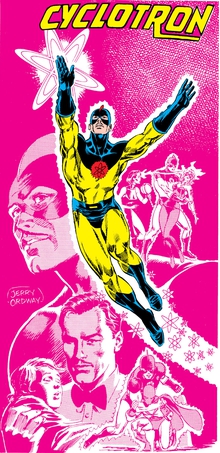Cyclotron is the name of two different characters appearing in American comic books published by DC Comics. Though a minor character, he holds an important place in the history of the Justice Society as a source of power and inspiration for both the Atom and Atom Smasher.
| Cyclotron | |
|---|---|
 The Terry Curtis incarnation of Cyclotron as depicted in Who's Who: The Definitive Directory of the DC Universe #5 (July 1985). Art by Jerry Ordway. | |
| Publication information | |
| Publisher | DC Comics |
| First appearance | Terry Curtis: Action Comics #21 (1940) as Cyclotron: All Star Squadron #21 (1983) |
| Created by | Terry Curtis: Jerry Siegel and Joe Shuster Cyclotron: Roy Thomas |
| In-story information | |
| Alter ego | Terrence Kurtzberger |
| Species | Metahuman |
| Abilities |
|
Publication history edit
Terry Curtis was originally an obscure one-shot Superman character in Action Comics #21 (1940) who was a scientist who was kidnapped by Ultra-Humanite and forced to build an "atomic disintegrator".
Roy Thomas reinvented the character as Cyclotron, a reluctant supervillain, in All-Star Squadron #21 (1983) from DC Comics. He was one of the few original villains retroactively added to DC's Golden Age era in the series.
Fictional character biography edit
Terry Curtis edit
Cyclotron was an atomic scientist in the 1930s and 1940s named Terry Curtis (born Terrence Kurtzenberg, he had later Anglicized his name). In the past, he had had a brief romantic relationship with Dannette Reilly, the second Firebrand. Curtis was eventually kidnapped by the villainous Ultra-Humanite (whose brain was in Delores Winters' body at the time) who sought to make use of the scientist's expertise with atomic energy. He was subjected to the Ultra-Humanite's experiments and exposed to radiation which granted him superhuman abilities.[1]
Used as a pawn by the villain, Curtis was forced to go up against the heroic All-Star Squadron. In the process, he waged battle with the original Atom, exposing the hero to powerful radiation. This later became the source of the Atom's own superhuman abilities. Cyclotron died trying to be a hero by taking the Ultra-Humanite into the atmosphere and allowing himself to blow up. Inspired by this selfless sacrifice (and the super-power left in its wake), the Atom would later adopt a costume patterned after Cyclotron's own.[2]
Curtis' daughter, similarly named Terri, entered the custody of Firebrand and the Atom. The two served as godparents to Terri's baby, with Curtis' ex-lover Firebrand raising the child herself. Though cured of any potential radiation poisoning, Terri had evidently absorbed a large dose of her father's energy and passed the side effects to her son Albert who became the hero Nuklon (later Atom Smasher).
Cyclotron II edit
In 2016, DC Comics implemented another relaunch of its books called "DC Rebirth", which restored its continuity to a form much as it was before The New 52. An unnamed Cyclotron appears in the crossover series Justice League vs Suicide Squad where it's revealed he was a member of the initial Suicide Squad. On a mission, to Jagsun, he organized a double cross to take the island's God-Engine for themselves. For that, Amanda Waller first hired Lobo to kill him and then activated the bomb in his body, detonating him.[3]
Powers and abilities edit
The first Cyclotron has immense strength, the ability to fly, project blasts of atomic energy, and manipulate matter on a molecular level. He can even sap his opponent's physique by touching them. He additionally possesses expertise in science.[4]
The second Cyclotron is capable of generating energy.
In other media edit
- An original incarnation of Cyclotron appears in the Super Powers Collection action figure line and its tie-in comic. This version, also known as Alex LeWitt, is an android built by Superman who has knowledge of every superhero and supervillain, can perform a powerful "twister punch", and is mostly incapable of independent thought.
- A figure of Cyclotron was released in the DC Universe Classics line in April 2010.
References edit
External links edit
- Cyclotron at Comic Vine